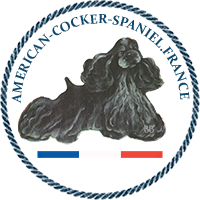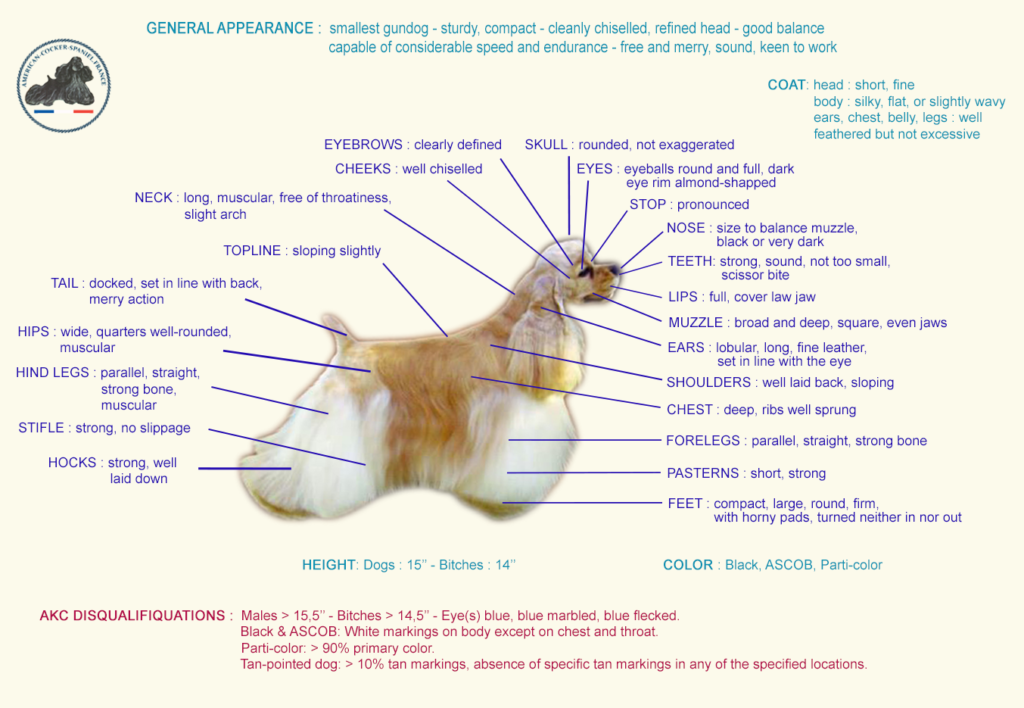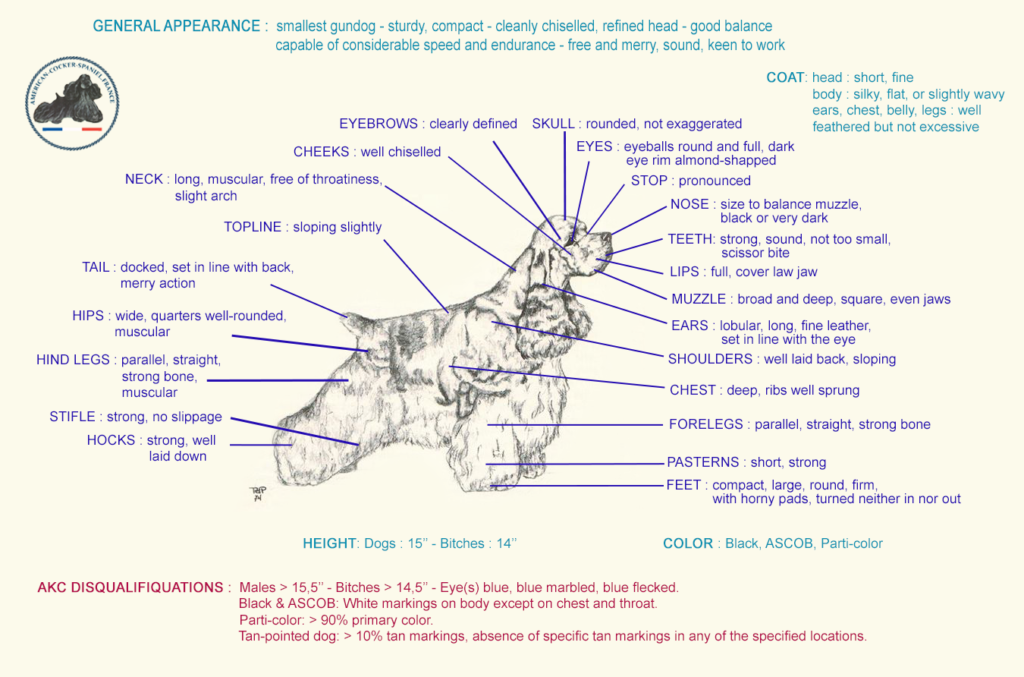Standard fci – English

Official Standard for the Cocker Spaniel
General Appearance:
The Cocker Spaniel is the smallest member of the Sporting Group. He has a sturdy, compact body and a cleanly chiseled and refined head, with the overall dog incomplete balance and of ideal size. He stands well up at the shoulder on straight forelegs with a topline sloping slightly toward strong, moderately bent, muscular quarters. He is a dog capable of considerable speed, combined with great endurance. Above all, he must be free and merry, sound, well balanced throughout and in action show a keen inclination to work. A dog wellbalanced in all parts is more desirable than a dog with strongly contrasting good points and faults.
Size, Proportion, Substance:
Size — The ideal height at the withers for an adult dog is 15 inches and for an adult bitch, 14 inches. Height may vary one-half inch above or below this ideal. A dog whose height exceeds 15½ inches or a bitch whose height exceeds 14½ inches shall be disqualified. An adult dog whose height is less than 14½ inches and an adult bitch whose height is less than 13½ inches shall be penalized. Height is determined by a line perpendicular to the ground from the top of the shoulder blades, the dog standing naturally with its forelegs and lower hind legs parallel to the line of measurement.
Proportion - The measurement from the breast bone to back of thigh is slightly longer than the measurement from the highest point of withers to the ground. The body must be of sufficient length to permit a straight and free stride; the dog never appears long and low.
Head: To attain a well-proportioned head, which must be in balance with the rest of the dog, it embodies the following:
Expression — The expression is intelligent, alert, soft and appealing.
Eyes — Eyeballs are round and full and look directly forward. The shape of the eye rims gives a slightly almond shaped appearance; the eye is not weak or goggled. The color of the iris is dark brown and in general the darker the better. Disqualifications: Eye(s) blue, blue marbled, blue flecked.
Ears — Lobular, long, of fine leather, well feathered, and placed no higher than a line to the lower part of the eye.
Skull — Rounded but not exaggerated with no tendency toward flatness; the eyebrows are clearly defined with a pronounced stop. The bony structure beneath the eyes is well chiseled with no prominence in the cheeks. The muzzle is broad and deep, with square even jaws. To be in correct balance, the distance from the stop to the tip of the nose is one half the distance from the stop up over the crown to the base of the skull.
Nose — of sufficient size to balance the muzzle and foreface, with well developed nostrils typical of a sporting dog. It is black in color in the blacks, black and tans, and black and whites; in other colors it may be brown, liver or black, the darker the better. The color of nose harmonizes with the color of the eye rim.
Lips — The upper lip is full and of sufficient depth to cover the lower jaw.
Teeth — Teeth strong and sound, not too small and meet in a scissors bite.
Neck, Topline, Body:
Neck — The neck is sufficiently long to allow the nose to reach the ground easily, muscular and free from pendulous "throatiness." It rises strongly from the shoulders and arches slightly as it tapers to join the head.
Topline — sloping slightly toward muscular quarters.
Body — The chest is deep, its lowest point no higher than the elbows, its front sufficiently wide for adequate heart and lung space, yet not so wide as to interfere with the straightforward movement of the forelegs. Ribs are deep and well sprung. Back is strong and sloping evenly and slightly downward from the shoulders to the set-on of the docked tail. The docked tail is set on and carried on a line with the topline of the back, or slightly higher; never straight up like a Terrier and never so low as to indicate timidity. When the dog is in motion the tail action is merry.
Forequarters: The shoulders are well laid back forming an angle with the upper arm of approximately 90 degrees which permits the dog to move his forelegs in an easy manner with forward reach. Shoulders are clean-cut and sloping without protrusion and so set that the upper points of the withers are at an angle which permits a wide spring of rib. When viewed from the side with the forelegs vertical, the elbow is directly below the highest point of the shoulder blade. Forelegs are parallel, straight, strongly boned and muscular and set close to the body well under the scapulae. The pasterns are short and strong. Dewclaws on forelegs may be removed. Feet compact, large, round and firm with horny pads; they turn neither in nor out.
Hindquarters: Hips are wide and quarters well rounded and muscular. When viewed from behind, the hind legs are parallel when in motion and at rest. The hind legs are strongly boned, and muscled with moderate angulation at the stifle and powerful, clearly defined thighs. The stifle is strong and there is no slippage of it in motion or when standing. The hocks are strong and well let down. Dewclaws on hind legs may be removed.
Coat: On the head, short and fine; on the body, medium length, with enough undercoating to give protection. The ears, chest, abdomen and legs are well feathered, but not so excessively as to hide the Cocker Spaniel's true lines and movement or affect his appearance and function as a moderately coated sporting dog. The texture is most important. The coat is silky, flat or slightly wavy and of a texture which permits easy care. Excessive coat or curly or cottony textured coat shall be severely penalized. Use of electric clippers on the back coat is not desirable. Trimming to enhance the dog's true lines should be done to appear as natural as possible.
Color and Markings:
Black Variety — Solid color black to include black with tan points. The black should be jet; shadings of brown or liver in the coat are not desirable. A small amount of white on the chest and/or throat is allowed; white in any other location shall disqualify.
Any Solid Color Other than Black (ASCOB) — Any solid color other than black, ranging from lightest cream to darkest red, including brown and brown with tan points. The color shall be of a uniform shade, but lighter color of the feathering is permissible. A small amount of white on the chest and/or throat is allowed; white in any other location shall disqualify.
Parti-Color Variety — Two or more solid, well broken colors, one of which must be white; black and white, red and white (the red may range from lightest cream to darkest red), brown and white, and roans, to include any such color combination with tan points. It is preferable that the tan markings be located in the same pattern as for the tan points in the Black and ASCOB varieties. Roans are classified as parti-colors and may be of any of the usual roaning patterns. Primary color which is ninety percent (90%) or more shall disqualify.
Tan Points — The color of the tan may be from the lightest cream to the darkest red and is restricted to ten percent (10%) or less of the color of the specimen; tan markings in excess of that amount shall disqualify. In the case of tan points in the Black or ASCOB variety, the markings shall be located as follows:
1) A clear tan spot over each eye;
2) On the sides of the muzzle and on the cheeks;
3) On the underside of the ears;
4) On all feet and/or legs;
5) Under the tail;
6) On the chest, optional; presence or absence shall not be penalized.
Tan markings which are not readily visible or which amount only to traces, shall be penalized.
Tan on the muzzle which extends upward, over and joins shall also be penalized.
The absence of tan markings in the Black or ASCOB variety in any of the specified locations in any otherwise tan-pointed dog shall disqualify.
Gait: The Cocker Spaniel, though the smallest of the sporting dogs, possesses a typical sporting dog gait.
Prerequisite to good movement is balance between the front and rear assemblies. He drives with strong, powerful rear quarters and is properly constructed in the shoulders and forelegs so that he can reach forward without constriction in a full stride to counterbalance the driving force from the rear. Above all, his gait is coördinated, smooth and effortless. The dog must cover ground with his action; excessive animation should not be mistaken for proper gait.
Temperament: Equable in temperament with no suggestion of timidity.
Disqualifications:
Height — Males over 15½ inches; females over 14½ inches. Eye(s) blue, blue marbled, blue flecked.
Color and Markings — The aforementioned colors are the only acceptable colors or combination of colors. Any other colors or combination of colors to disqualify.
Black Variety — White markings except on chest and throat.
Any Solid Color Other than Black Variety — White markings except on chest and throat.
Parti-color Variety — Primary color ninety percent (90%) or more.
Tan Points — (1) Tan markings in excess of ten percent (10%); (2) Absence of tan markings in Black or ASCOB Variety in any of the specified locations in an otherwise tan-pointed dog.
Approved January 9, 2018
Effective March 1, 2018


